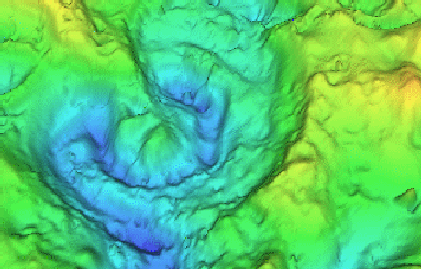Credit & Copyright: courtesy V.L. Sharpton,
LPI
Explanation:
What killed the dinosaurs?
Their sudden disappearance 65 million years ago,
along with about 70 percent of all species then living on Earth, is
known as
the K-T event (Cretaceous-Tertiary Mass Extinction event).
Geologists and paleontologists often
entertain the idea of a large
asteroid or comet impacting the Earth as the culprit.
Besides the firestorms, tidal waves, earthquakes, and hurricane winds
such an impact would generate, the
debris thrown into the atmosphere would have a serious global environmental
impact -- creating extended periods of darkness,
low temperatures, and acid rains.
In 1990, dramatic support for this theory came
from cosmochemist Alan Hildebrand's
revelation of a 65 million year old, 112 mile wide ring structure
still detectable under layers of sediment in the Yucatan Peninsula
region of Mexico.
The outlines of the structure, called
the Chicxulub crater
(named for a local village), are visible in
the above representation of gravity and magnetic field
data from the region.
In addition to having the right age, the crater is consistent with
the impact of an asteroid of sufficient
size (6 to 12 miles wide) to cause the global disruptions.
Regardless of the true cause of the K-T event, it is
fortunate that such impacts are presently believed to happen
only about once every 100 million years!
1999 2000 2001 2002 2003 2004 2005 2006 2007 2008 2009 2010 2011 2012 2013 2014 2015 2016 2017 2018 2019 2020 2021 2022 2023 2024 2025 |
Январь Февраль Март Апрель Май Июнь Июль Август Сентябрь Октябрь Ноябрь Декабрь |
NASA Web Site Statements, Warnings, and Disclaimers
NASA Official: Jay Norris. Specific rights apply.
A service of: LHEA at NASA / GSFC
& Michigan Tech. U.
|
Публикации с ключевыми словами:
Earth - dinosaur - impact crater - ударные кратеры - Земля
Публикации со словами: Earth - dinosaur - impact crater - ударные кратеры - Земля | |
См. также:
Все публикации на ту же тему >> | |
